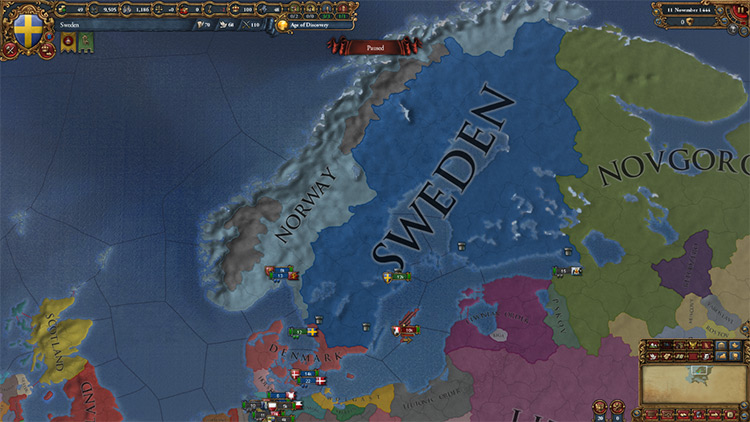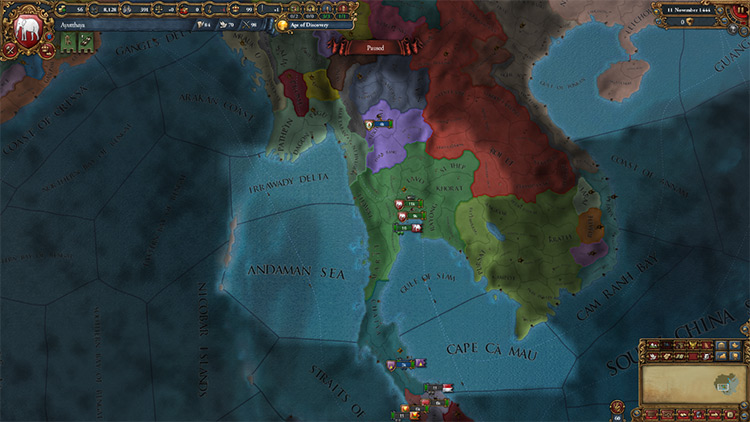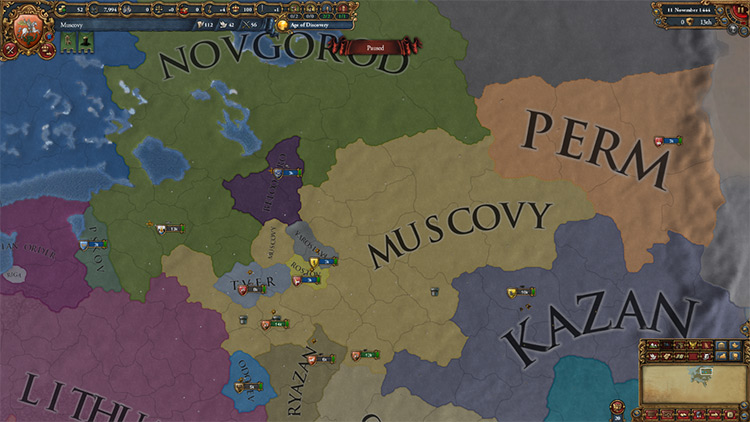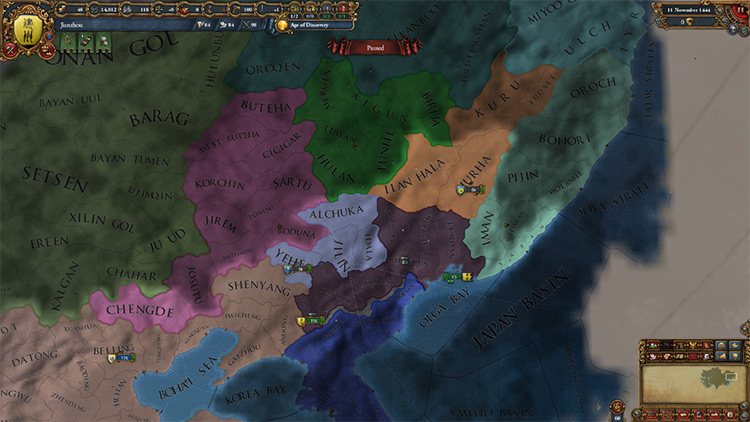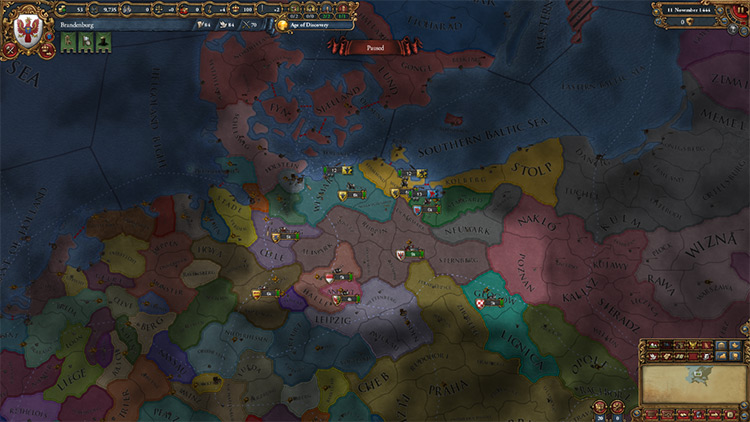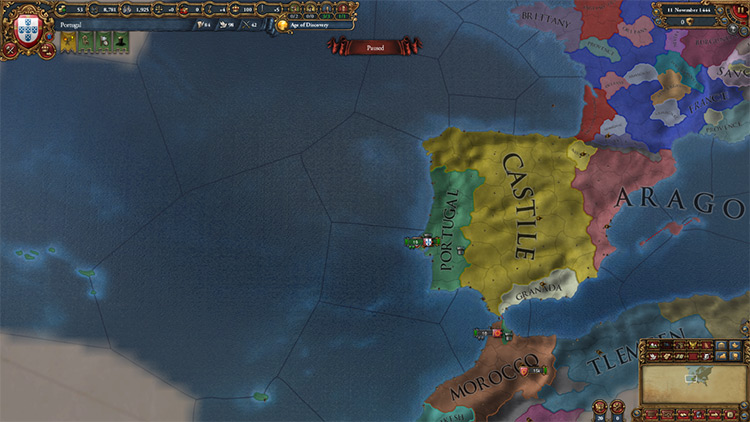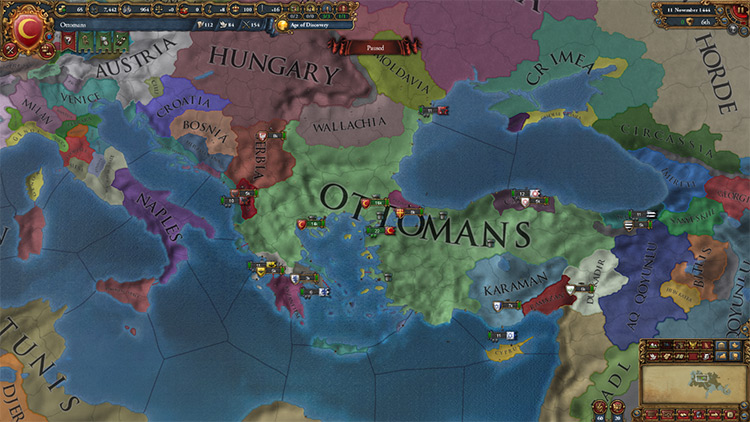Sadly, the game’s tutorial might as well be non-existent. It doesn’t go into any meaningful depth and offers little explanation of core mechanics. You’re encouraged to explore the game’s various mechanics by playing. This isn’t a bad approach per se, but it can prove to be tedious. I’ve known lots of people who stopped playing because they couldn’t succeed even remotely. To avoid these shortcomings, I’ve ranked the best nations (in my opinion) that are the best tools to learn EU4 with. And each nation offers a different campaign that emphasizes certain game mechanics over others.
7. Sweden
Sweden starts the game under a personal union with Denmark. It’s essentially a subject nation. This makes its situation more precarious than other nations on the list, but at the same time it’s part of the reason Sweden even makes the list. This starting situation can teach you how to secure your independence when you play as a vassal. Securing allies and how to fight your overlord is a valuable lesson to learn. After that, Sweden has some insanely powerful military modifiers through ideas and events, including the strongest single national idea in the game, +20% infantry combat ability. This can offer another lesson about unit superiority in the field of battle. In a relatively safe position for the early game, Sweden will eventually have to content with the Russian bear to the east. Securing the Baltic coastline makes for a nice goal that can lead you to various interesting conflicts.
6. Ayutthaya
Ayutthaya is the predecessor of the modern state of Thailand. It’s my recommendation for a beginner campaign outside of Europe. Ayutthaya is undoubtedly the strongest power in Indochina. It possesses strong ideas, flavorful events, and a detailed mission tree to guide your expansion. The campaign can teach you vassal management and land warfare at its core. You may start as a Ming tributary, but you won’t stay one for long. This can force you to explore ways of attacking nations protected by Ming and learn how to play in the Chinese Emperor’s shadow. An introduction to other religions outside Abrahamic ones is another plus of the campaign. India is nearby, so you can get a taste of how things develop over there. Note: I decided against including any Indian nations on this list because they’re quite complicated, and all of them face serious threats early on.
5. Muscovy
Muscovy offers a nice change of pace from other European nations. Situated at the fringes of Europe proper, a Muscovy campaign plays out more like one in Asia would. This offers a great opportunity to get a taste of inland Asia while still having a familiar religion and technology group. Muscovy admittedly isn’t the easiest of nations. There are threats in every corner, and you need to be cautious. The hordes to your east are more powerful than you in the early game. Their manpower and military capabilities can make it hell for you to fight them, even if you win the war. However, being stronger than your rival of Novgorod, you’re in a great position to secure the Russian region and eventually form Russia. Colonizing Siberia and pushing eastwards while pacifying the steppe can teach you how to manage large land empires and handle subjects of a different religion.
4. Jianzhou
Jianzhou takes its place on the list representing horde gameplay and Celestial Empire mechanics. Your starting position is excellent: you have all the tools to go ham and conquer all your northern neighbors in Manchuria. After doing that and forming the nation of Manchu, you’ll find yourself in the Chinese culture group with two routes going forward. Expand west into Mongol lands or move against the Ming dynasty. You can in fact fight Ming and win as early as 1445. This can teach you the game’s horde mechanics, looting and razing, as well as how powerful they can be in the early game. The first time you crush Ming outnumbered 10 to 1 is something you will always remember. Eventually forming Qing and transitioning away from a horde and into a Celestial Empire, you can learn how to manage mandate and play as the Chinese emperor. And while this is great for beginners, there’s still lots of learning along the way. Securing vassals, ensuring prosperity in states, and passing reforms aren’t as simple as they seem.
3. Brandenburg
The Hohenzollern dynasty of Brandenburg is an excellent beginner’s choice for learning how to play inside the HRE. Starting as an elector of the HRE and one of the most powerful nations inside it, Brandenburg has multiple options regarding its stance towards the empire. You can make a bid for emperorship and try to lead the empire from the north, or try to forge your own path in the east and solidify your rule in northern Germany. In both cases, you’ll have to contend with the emperor in Vienna. Brandenburg has a unique mission tree that it shares with Prussia, a nation which it can form under very specific conditions. One of these is embracing the reformation, adding the mechanics around changing religions into the mix. After securing the Prussian lands and forming the nation, you find yourself in control of what is accurately described as an army with a state. Prussia, like Sweden, is one of the strongest military nations in the game. This comes at a cost of governing capacity though, forcing you learn how to efficiently govern your lands while enjoying these awesome military bonuses.
2. Portugal
Portugal begins the game in one of the safest positions on the map. Allied with England from the beginning & having a historical friend in Castille means that no one will bother you in your little corner unless you provoke them. This campaign is recommended by the game itself as one suitable for beginners. A typical campaign as Portugal will of course be focused on colonization. And with colonization being a major part of the game, Portugal is an excellent choice to learn how it works. Being able to easily colonize into the new world and into Africa and the East Indies, Portugal can teach a new player both sides of colonialism. Managing colonial nations and building up trade companies are a couple of mechanics that you will have a blast learning in a typical campaign as Portugal. Building up a small and compact core territory also offers an introduction to the “tall” playstyle. Later if you feel strong enough, you can of course try and carve yourself a European empire starting with Iberia. Put those hard-earned trade money to good use.
1. Ottomans
Well, the game’s bookmark in 1444 isn’t called the “Rise of the Ottomans” for no reason. The fledgling sultanate is unquestionably the star of the show. On top of that, it’s also the best choice for a beginner. To put it simply, Ottomans are too big to fail. Their early game is unmatched. They literally get substantially better units than the rest of the map until the mid-16th century. Your only problem can be coalitions, and that in itself is also a valuable lesson for a beginner. Uncontrolled expansion will lead to your neighbors getting angry and banding up against you. Every one of us has had it happen when first trying the game! Aside from how to handle aggressive expansion, an Ottoman campaign has a little bit of everything. You will need to plan wars ahead of time and decide what to demand in a peace deal, as you’ll be fighting equally sized nations, mainly the Mamluks. You’ll also learn how to allocate merchants, what provinces to state, and how to handle your religious minorities through estates and other modifiers. Eventually you armies will start falling off into the late game, which can intuitively teach you that there are optimal windows to tackle a certain foe. And learning how to beat the Ottomans is even easier when you’ve played as them first!
